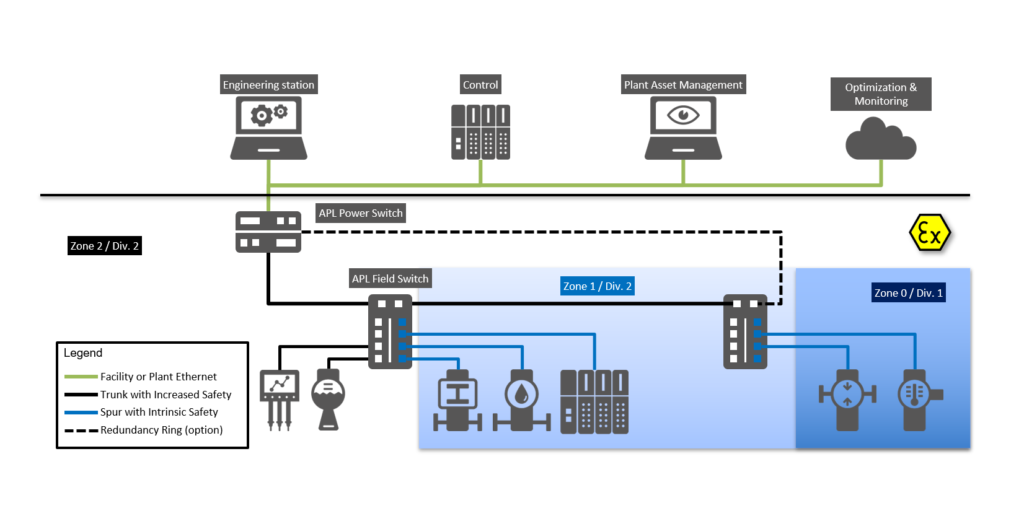Current Situation
Systems currently in use in the process industry are typically equipped with 4–20 mA analog technology in conjunction with HART or with fieldbus infrastructures. Due to their low transmission rates (e.g., the HART protocol’s 1.2 kbit/s), these infrastructures are not suitable for future system concepts with data-intensive applications like the Industrial Internet of Things, Industrie 4.0, and the NAMUR Open Architecture.
In factory automation, in particular, Ethernet-based communication technologies serving as the basis for the system concepts mentioned above have been used as standard since the early 2000s. A variety of different communication protocols are used here. On the physical level, these networks are based on the IEEE 802.3 Ethernet standard with 4-wire and 8-wire Ethernet cables, but this standard is currently unable to meet the special requirements of the process industry.
Requirements of the Process Industry
In the process industry, aspects like topology (trunk/spur installation), 2-wire technology (communication and power supply over the same cable), long distances, and intrinsic safety – in particular – are paramount. “Long distances” refers to cable lengths of several hundred meters, with spans even up to 1,000 m having to be overcome. Since the supplying of power to field devices over the same 2-wire cable used for data communication has proven itself in previous fieldbus installations, this feature should not be left out. The installation of Ethernet-capable field devices in hazardous areas (Zone 0, Class 1/Division 1) rounds out the requirements of the process industry.
Current Status of the Specifications
To implement the vision of “Ethernet for every field device in the process industry” while taking all the requirements into account, the Profibus & Profinet International (PI), FieldComm Group (FCG) and ODVA organizations are all cooperating on the “Ethernet-APL Project”, with the Ethernet Advanced Physical Layer (APL) being the focal point. Various different work packages and milestones are pursued by corresponding work groups:
- Expansion of the IEEE Ethernet standard: IEEE 802.3cg (10BASE-T1L) specifies 2-wire Ethernet with segment lengths of up to 1,000 meters, a transmission rate of 10 Mbit/s and optional power supply over the same cable
- Specification of port profiles for the power supply
- Expansion of the IEC specification to include explosion-protection methods for intrinsic safety (2WISE, or 2-Wire Intrinsically Safe Ethernet).
- Integration of the option for 10BASE-T1L into the protocol-specific specifications (e.g., PROFINET)
- Planning and installation guidelines
- Test standards
The work packages and specifications will all be completed before the end of 2021. The first Ethernet-capable field devices for hazardous environments will then be available.
Benefits
Thanks to the focus on the requirements of the process industry, cooperation among the largest organizations, and collaboration by large industrial companies in the field of process technology, a crucial foundation for digitization in process automation is being laid with Ethernet-APL. Regardless of the communication protocol used, Ethernet-APL enables the consistent integration of office infrastructure down to the field level on the physical level, significantly supporting the transparency and information exchange between the OT and IT in so doing.
Further Information
For more details, see the Ethernet-APL white paper at: https://www.profibus.com/apl


